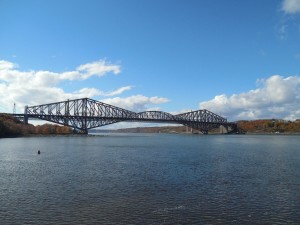
By Hoang-Nam Vu, Staff Writer for Save The Water™ | February 6, 2016
Problem
The St. Lawrence River is a central entity of Quebec, Canada. First notable as a passageway into America and a place of inquiry by explorers like John Cabot and Jacques Cartier, it has become a source of Montreal’s economic, social and cultural development. Today, its shores and tributaries are home to over 80% of Québec’s population, and 50% of Quebecers get their drinking water from these watercourses. It’s safe to say that the St. Lawrence River, and its sanitation, is vital to the health of the community. This fact was central to the outrage over actions taken by the government of Montreal (Canada’s second largest city). On November 8th, the Liberal minister of environment, Catherine McKenna, approved Montreal’s plan to dump 8 billion liters of untreated sewage into the St. Lawrence River.1 This action was a byproduct of a repair operation aimed at replacing dilapidated parts of the waste treatment system.
McKenna defended the decision, stating that “This release is far from ideal, but it is needed for the city of Montreal to perform critical maintenance on their infrastructure before winter”.1 In response to the growing indignation among environmentalists and citizens alike, the city said that the dump will have little effect on the river’s fish population and will not affect drinking water quality for residents.3 Yet these statements were disregarded by enraged critics.
Effects
Widespread disapproval of this decision was vocalized throughout the province and reached a head in Montreal itself. Many criticized the effect of the dump on the local ecosystem. The river is known for its rich wildlife, including endangered turtles, bald eagles, and osprey, which could be threatened by the spill, environmental groups say. It also provides drinking water to many Canadians.1 The river houses a number of beluga whales, a near-threatened species, according to the World Wildlife Fund. The dump could negatively affect the diverse inland ecosystem of the river, as numerous north woods mammal species find their home on the shores and islands of the river, including muskrat, beaver, flying squirrels, mink, deer, porcupine, and many others. Winter ice cover on the river provides important passage for animals from the shoreline and to/from many of the islands.4 The river is also a central area of the Atlantic Flyway, a vital migratory route for numerous avian species indigenous to the area. Even more were outraged at the urban effect of the dump. Many condemned the effect that the dump would have on the local drinking water, as many denizens of the area obtain most to all of their water from the river.
The outrage over this action might have been centralized in Montreal, but many Americans, especially those from New York, expressed their disapproval of the decision. NY Senator Chuck Schumer and NY State Senator Patty Ritchie were among the state officials to publicly denounce the decision. The basis of Schumer’s criticism was the potential effect on the tourism of not only Montreal but the upper regions of New York as well. He appealed Friday [October 9th] to the U.S. State Department and Environmental Protection Agency to halt the plan, citing the potential impact on tourism and the St. Lawrence River ecosystem (The US EPA said they did not have jurisdiction in Canada).5 Jefferson County legislator Phil Reel also criticized this decision, stating that “It’s [the St. Lawrence river] a resource vital to both communities”.3
Concerns
Jefferson County lies at the head of the river. Ritchie lambasted the precedent Montreal’s action was set. She stated “While I realize that the dumping will occur in Canadian waters, downstream from any U.S. communities, I am very concerned by the precedent Montreal is setting for other communities along the St. Lawrence and the lakes”.5
Ritchie wasn’t the only one worried about how this action would affect other communities along the river. Lee Willbanks, from the advocacy group Save the River, mentioned “If Montreal does it, other municipalities might do the same”.3 And this statement was within good reason considering Canada’s history regarding raw sewage dumps. Sewage was pumped into the Halifax harbor until 2008 (and there are claims that it still is). Millions of liters of raw sewage has been dumped into the rivers of Winnipeg since 2004. Victoria and Esquimalt have been in a longtime battle with the federal and provincial government concerning their sewage treatment practices, and in 2013, Toronto was flooded with raw sewage water based on heavy rainfall.2
Even disregarding these instances, Montreal’s decision remains controversial. Alexandre Joly, head of a non-profit group devoted to improving the quality of water in St. Lawrence and access to it, said it best. “You have to remember that whatever you put in the toilet for the next week is going to go directly into the river”.3
References
- Kozlowska, H. (2015, November 10). Canada’s new government just approved dumping raw sewage into the St. Lawrence river. Retrieved January 23, 2016, from http://qz.com/545922/canadas-new-government-just-approved-dumping-raw-sewage-into-the-st-lawrence-river/
- News, C. (2015, October 06). St. Lawrence not only Canadian waterway sullied by raw sewage.Retrieved January 23, 2016, from http://www.cbc.ca/news/canada/montreal/raw-sewage-common-problem-examples-1.3258594
- Reuters. (2015, November 11). Montreal starts dumping 2 billion gallons of raw sewage into St.Lawrence River. Retrieved January 23, 2016, from http://nypost.com/2015/11/11/montreal-starts-dumping-2-1-billion-gallons-of-raw-sewage-into-st-lwrence-river/
- Save the River. (2014). St. Lawrence River Ecosystem. Retrieved January 23, 2016, from http://www.savetheriver.org/index.cfm?page=app.riverEcosystem
- Weiner, M. (2015, October 9). Schumer: Canada must stop Montreal from dumping sewage into St. Lawrence River. Retrieved January 23, 2016, from http://www.syracuse.com/politics/index.ssf/2015/10/schumer_canada_must_stop_montreal_from_dumping_sewage_into_st_lawrence_river.html

